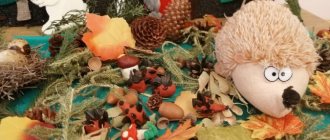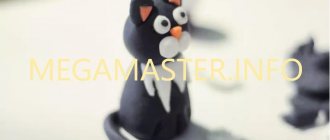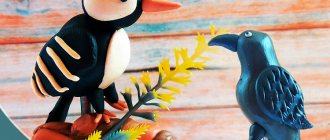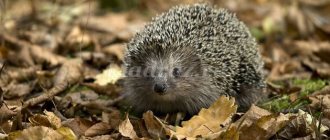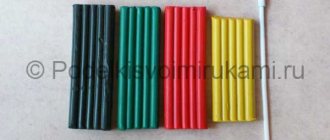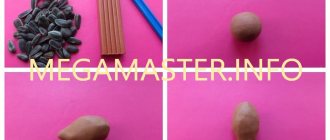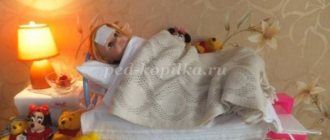MAGAZINE Preschooler.RF
Notes on modeling for children of the middle group “Dishes for dolls”Goal: Expand children's understanding of surrounding objects
Educational objectives:
- Strengthen children's ability to sculpt dishes.
- Practice sculpting techniques.
Developmental tasks:
- Activate vocabulary on the topic of tableware (sugar bowl, teapot, cups, saucers, thrush, spoons)
- Develop fine motor skills and eye.
Educational tasks:
- Arouse interest in teamwork to create a tea set for dolls.
- Foster activity, independence and accuracy in work.
Equipment. Doll dishes, bunny, plasticine, modeling board, stacks.
Preliminary work. Looking at tea sets at home, illustrations. D/I “Pick a Pair”
,
"What is missing"
.
Progress of the lesson.
1. Organizational moment.
The teacher leads the children to the group where the guests are sitting. Guys, look how many guests came to us! Let's say hello to them. (Children greet guests)
Children sit in a semicircle.
“Tea Party” by V. Shipunova
.
Like our Dunya’s cups and saucers, Like our Lyusenka’s little ones asking for tea:
- You are welcome - Come and visit. Come to visit. Come for some cookies
This is simply delicious - Visit the dolls on their birthday!
2. Game situation.
Educator. Guys, look who came to us? (Bunny)
A bunny came to us for help, he told me that the dolls and their friends want to have a party (a birthday, but they don’t have enough dishes. Let’s help the toys by making teaware for them.
Educator: Let's go with you to our workshop.
— Guys, look what’s on my table? (Tea-set)
There is a tea set on the table. Tell me what utensils are included in the tea set. (Children name: teapot, sugar bowl, cups, saucers, thrush; remind that all the items in the service are decorated the same way - polka dots, flowers, checkered patterns or something else. Children remember the tea sets they saw at home.
Comparison of dishes.
Educator: How are they different and similar: a plate and a saucer; cup and mug?
Game “Name what kind of dishes”
.
If the plate is made of plastic, then it is (what?)
-... If the spoon is made of metal, it is... If the cup is made of porcelain, it is... If the glass is made of glass, it...
If the sugar bowl is made of glass, then it... If the ladle is made of metal, it...
Physical education minute.
We begin exercises, standing in a circle, stretching our arms, jerking with our arms. Stretch your back and shoulders, turn right and left. To make it easier for us to sit.
Let's jump together, jump and jump! Jumping in place. Who will get the ceiling? Now walk in place. Walking. Let's all clap loudly together. Claps.
We quickly sat down at the tables and got down to business. Modeling cup and saucer.
Children make a plate out of a ball, flatten it and bend the edges a little, and decorate the plate with circles or stripes.
The cup is made from a ball, pressed a little into the middle, a handle is attached to the right. The cup can be made of any shape.
And before work, we will stretch our fingers.
Finger gymnastics “Knock-knock-knock”
.
Fingers came to visit,
Knock, knock, knock - they knocked on the door. Children tapping on the table
Only the door was not opened for them: with the pads of all fingers
They thought there was a terrible beast there. simultaneously.
The guys start working, they can implement any ideas. Offer to show the children some techniques for decorating tea cups, reciting all the actions ( “with a stripe”
— roll out a long flagellum and lay it along the rim - straight or in a wave).
Final part.
At the end of modeling, place all the works on the table and, together with the bunny, carefully examine them, draw the children’s attention to a more accurate representation of the shape of the dishes, to accuracy in work. Emphasize the variety of products and give them to dolls for their birthday.
| Next > |
Outline plan “Modeling dishes based on the work of K. I. Chukovsky “Fedorino Mountain”
Avakyan Irina Alekseevna
Outline plan “Modeling dishes based on the work of K. I. Chukovsky “Fedorino Mountain”
Outline
Modeling dishes based on the work of K. I. Chukovsky “ Fedorino grief ”
Program content. Strengthen sculpting . Form aesthetic taste. Learn to finish what you start. Develop fine motor skills of the hands.
Equipment. Clay, planks, saucers with damp cloths, a large board.
We remember with the children of K. Chukovsky " Fedorino grief "
, shows illustrations for it, we talk about what we read.
Starting the lesson, I say that today we will sculpt on the theme of the poem “
Fedorino Grief ” .
- What is it talking about, Nastya? That's right, about how the dishes ran away from the dirty and slobby Fedora . What else?
— Fedora said that she would wash the dishes , and the dishes took pity on her and returned.
- What kind of dishes are they talking ?
— About plates, glasses, cups, a kettle.
- Right! Here I am showing you Fedora . Now do the dishes . Think first about who will sculpt what kind of dishes . Daniil, have you figured out what you will sculpt?
— You can sculpt different dishes . Let's immediately agree on what we will depict: how the dishes run away from Fedora or how they come back. (Asks to say several children.)
Everyone wants us to depict
the dishes running away from Fedora . She is sad, crying, running for her dishes .
During the lesson, I help the children with advice and demonstration.
At the end, I approve of the children’s actions and show them interesting, correctly completed work. Children take turns placing their dishes .
Photo report on the collective work in the junior group based on the work of Korney Chukovsky “The Tsokotukha Fly” For the anniversary of Korney Chukovsky, a collective work was carried out with elements of plasticineography and appliqué elements. This work was. Photo report “Musical performance “Fedorino Grief”” Purpose of the holiday: Creating a positive, emotional mood on the eve of the holiday. The purpose of the holiday: To instill a sense of confidence. Summary of a game-lesson on speech development “Miracle Tree” based on the work of K. Chukovsky Purpose: To develop children’s interest in didactic games, to develop children’s ability to generalize objects. Didactic tasks: 1. Teach children.
Source
GCD for the NGO "Artistic Creativity" (modeling) based on the fairy tale by K. I. Chukovsky "Fedorino's Mountain"
Alena Dzoblaeva
GCD for the NGO "Artistic Creativity" (modeling) based on the fairy tale by K. I. Chukovsky "Fedorino's Mountain"
Goal: strengthen sculpting .
Arouse children's interest in the images of fairy tales ; continue to form an interested attitude towards collective activities. Reinforce the techniques of sculpting dishes from a round shape by pressing the clay with your fingers, continue to learn how to sculpt dishes using the tape method.
If children wish, teach them to sculpt a cat, achieving expressiveness of the image.
Equipment: Clay. stacks of wet rags; a doll dressed as Grandma Fedora .
Areas: " Artistic creativity "
,
“Cognition”
,
“Communication”
,
“Socialization”
.
Reading by K. I. Chukovsky “ Fedorino grief ”
The teacher invites the children to sculpt dishes and cats from K's fairy tale . I. Chukovsky (Specifies what kind of dishes are mentioned in the poem , and the methods for sculpting )
For those who expressed the idea of blinding the cats, the teacher reminds them that the cats looked with surprise and fear at the fleeing dishes. He gets the kids to describe the frightened animals themselves ( “dressed up”
tails, arched backs, etc.)
Children can make any type of pottery, but ribbon sculpting .
At the end of the lesson, the teacher brings in a doll dressed as Fedora Egorovna , and the preschoolers place their work around it.
the fairy tale again . If children know these lines by heart, then they themselves can address the cats and plates on behalf of them.
Subsequently, the fashioned dishes are used in games.
Artistic creativity - modeling “Goldfish” (applying plasticine to the surface). Preliminary work is important (reading works of fiction, looking at postcards, drawings, toys, watching video materials).
Summary of an integrated lesson on the fairy tale by K. I. Chukovsky “Fedorino's grief” (middle group) Program objectives: to help children understand the humor of this work. Identify the funniest episodes. Teach children to watch cartoons carefully.
Summary of an integrated lesson based on the fairy tale by K. Chukovsky “Fedorino's Mountain” Methodological development based on the fairy tale by K. Chukovsky “Fedorino's Mountain” Objectives: 1. To cultivate frugality in children, a love of cleanliness and neatness.
Summary of an integrated lesson in the senior group “Fedorino Gore” Synopsis of an integrated lesson in the senior group “Fedorino Gore” (conversation) Purpose: To develop social and healthy skills in children.
GCD for modeling “Sparrow” 1. According to the method of T. S. Komarova, in the third quarter of the middle group, children must be taught to divide plasticine into several parts. However, possibilities.
GCD Speech development "Fedorino's grief" for children of the senior speech therapy group GCD Speech development on the topic "Fedorino's grief" Compiling a descriptive story using a mnemonic table. (For children of senior speech therapy.
Drawing based on the fairy tale by Korney Ivanovich Chukovsky “Fedorino’s Mountain” My short-term project is called “The Magic World of Korney Chukovsky”. It was not in vain that I chose this particular topic, because I think...
Summary of the lesson on modeling “Fedorino Mountain” (middle group)
Mulyukova Alesya
Summary of the lesson on modeling “Fedorino Mountain” (middle group)
Summary of the lesson on modeling “Fedorino Mountain” (middle group)
Topic: “Fedorino’s grief.”
Goal: developing children's creative skills in the process of modeling from plasticine.
Tasks:
1) develop fine motor skills during the modeling process and emotional responsiveness to the results of one’s own creativity and the creativity of other children;
2) to form children’s concept of the properties of the material, generalize children’s concept of pasuda;
3) to promote the skill and ability to roll out sausages from plasticine between the palms with direct movements of the hands, to create a craft in an original way of modeling (by twisting the sausages in the shape of a mug or plate);
4) cultivate a sense of empathy and the desire to help those in trouble.
Work on the dictionary: trough, sieve, poker, samovar, tub.
Techniques for managing children's activities:
1. Techniques for setting goals and motivating children’s activities:
Korney Chukovsky’s fairy tale “Fedorino’s Grief”, awaken empathy and the desire to provide support. Discuss possible options for help and determine the goal (to fashion the broken dishes).
2. Techniques for enhancing children’s activities in the OD process:
conversation, formation of the environment, surprise moment (Grandma Fedora, various dishes, creation of a problem situation, analysis, conclusions).
3. Techniques for organizing practical activities for children:
modeling dishes.
4. Techniques for maintaining interest in children:
situation of choice, physical education break “Fedorino’s grief”, alternation of activities.
5. Assessment and self-assessment techniques:
encouraging mutual assistance among children.
Creating an environment for organizing and conducting OA:
Fairy tale characters (toys: grandmother’s doll, dishes); plasticine (for each child, modeling boards, napkins, oilcloth, easel, sample dishes, fairy tale illustrations).
Types of children's activities in OD:
Gaming (p/n:
“Fedorino’s grief”, physical education lesson).
Communicative
(guessing a riddle, reading a fairy tale).
Cognitive and research
(discussion of the task, its analysis and drawing conclusions).
Productive
(modeling dishes from plasticine).
Reading fiction
(reading Korney Chukovsky’s fairy tale “Fedorino’s grief”).
Planned results:
Personal:
empathizes with those in trouble, shows emotional responsiveness, and is friendly in activities and communication with adults and peers.
Intelligent:
takes an active part in solving the problem, can independently choose methods and techniques of sculpting, creates a composition using a constructive sculpting method
Physical:
active and mobile, independently performs movements in the game.
Criteria for assessing children's activities in class:
1. Activity
(active in games, discussions, activities).
2. Independence
(able to independently solve the task of creating a fragment of a composition).
3. Interaction with peers and adults
(able to turn to the teacher and other children for help, able to help children in difficulty himself).
4. Empathy
(able to empathize with those in difficult situations).
5. Emotionality
(emotionally responsive (shows interest in all types of activities).
6. Manifestation of volitional efforts
(able to finish what he started).
7. Self-esteem
(able to evaluate the results of his own activities and the activities of other children).
Integration of educational areas:
Objectives: To help children implement independently acquired knowledge and methods of activity to solve new problems (problems posed by both adults and themselves. Enrich the listening experience of children, develop the ability to distinguish the elementary nature of music, understand the simplest musical images.
Cognitive development: looking at illustrations, conversation.
Objectives: Development of children's interests, curiosity and cognitive motivation; development of imagination and creative activity.
Speech development: reading a fairy tale, guessing a riddle.
Objectives: Enrichment of active vocabulary, development of sound culture of speech, listening comprehension of texts of various genres of children's literature.
Social and communicative development: formulation of a problem situation, formation of emotional responsiveness, empathy.
Objectives: Developing the ability to understand speech instructions to achieve a positive result in activities. Development of figurative representation based on the perception of the surrounding reality and works of art; formation of emotional responsiveness and empathy.
Physical development: p/games: “Fedorino’s grief”, physical exercises.
Objectives: Accumulate and enrich children’s motor experience, cultivate a culture of movement, and develop physical qualities.
Preliminary work: examining various dishes, discussing what kind of dishes are made, from what materials, reading poems and riddles.
Lesson plan:
1. Introductory part (3 minutes):
Creating a problem situation (reading a fairy tale).
Creating a motive for children's activities (helping grandmother Fedora).
Goal definition, analysis.
2. Main part (10 minutes):
A surprise moment - toys of fairy tale heroes (Grandma Fedora doll, toy and real dishes).
Productive activity: Modeling (dishes).
3. Final part (2 minutes):
Conversation. Assessment of children's activities. Summing up the lesson.
The duration of the lesson is 15 minutes.
Progress of the lesson.
Children are sitting on the carpet.
V.: Children! Today I will tell you a very interesting fairy tale, many of you, I think, are already familiar with it, don’t our parents read fairy tales to us?
V.: I’ll check it now, guess the riddles
He scolds the unwashed
He washes himself cleanly (“Moidodyr”)
I got caught in the web. (fly Tsokotukha)
Scared all the forest animals
Except the brave sparrow (“Cockroach”)
V.: You know the rules and everyone, but now I’ll tell you a riddle about the fairy tale that we will read today.
Who does not wash, does not wash,
